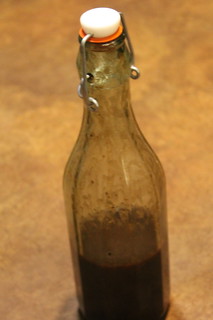Taking a quick look at the list of ingredients on your favorite bottle of store-bought dressing can be a real eye opener. In fact, you may be surprised to see a host of ingredients you weren’t expecting, including high-fructose corn syrup and other sweeteners, trans fats, MSG, and an assortment of artificial colors and preservatives - all to make it all seem more fresh and "natural" - when in fact it is anything but.
| (Photo credit: SliceOfChic) |
When it comes to homemade salad dressings, vinaigrettes are fast, easy and delicious choices. One general rule of thumb to keep in mind when creating your own vinaigrettes is to use 1 part vinegar (or other acidic ingredient) to 3 parts oil. In other words, if you use ¼ cup vinegar, you’ll want to use ¾ cups of oil. If you like a little more kick to your dressing (like I do), try a 2:1 ratio instead.
When choosing these key ingredients, don’t be afraid to get creative. Think beyond plain white, red or cider vinegar and give rice vinegars, aged or white balsamic, or fruit-infused varieties a try as well. Citrus juices, such as lemon, lime, orange and grapefruit, also work particularly well.
When it comes to choosing your oil, it’s hard to beat a high-quality extra virgin olive oil. However, you may want to consider other healthy alternatives, such as a more delicate grape seed oil, as well. Olive oils infused with garlic, rosemary or other herbs are also great choices.
A third ingredient you may want to add to your vinaigrette is Dijon mustard. Dijon is a popular choice because it tastes great and acts as an emulsifier, helping to bind all the other ingredients together and keeping the oil and vinegar from separating as quickly.
Beyond these three ingredients, there are countless ways you can customize your vinaigrette recipes to complement your salad ingredients. For example, you can add minced garlic, onion, shallots, fresh or dried herbs, honey, or a variety of fruit juices or zests.
Here is a basic recipe to get you started:
| Balsamic Vinaigrette Dressing (Photo credit: Chris and Jenni) |
3/4 cup olive oil
1/4 cup balsamic vinegar
1 teaspoon Dijon mustard
2 teaspoons honey
1-2 cloves finely minced garlic
salt and pepper, to taste
Combine all ingredients in a glass bowl or container with tight-fitting lid. Mix or shake vigorously to combine thoroughly.
Starting with this basic recipe, and tweaking with different vinegars and herbs to suit your taste, I bet you can come up with dozens of yummy options to suit whatever salads are on your menu this spring and summer. Enjoy!
And be sure to check back later this week for some tasty salad recipes with fresh dressings you can make at home!



No comments:
Post a Comment
We welcome comments and suggestions!